
HEILBRON
 A town in the Northern Free State, position: 27.2895°S, 27.9696°E, 1556 m altitude. It is not named (and misspelled) after Heilbronn in Germany. But rather named as such because of the fountains of fresh water found on the banks of the Elandsspruit. Its from Dutch, bron is a fountain and heil meaning healthy. So there you have it, its not a colonial name, so leave it alone.
A town in the Northern Free State, position: 27.2895°S, 27.9696°E, 1556 m altitude. It is not named (and misspelled) after Heilbronn in Germany. But rather named as such because of the fountains of fresh water found on the banks of the Elandsspruit. Its from Dutch, bron is a fountain and heil meaning healthy. So there you have it, its not a colonial name, so leave it alone.
Also related to Heilbron check out the following pages: Groenvlei, a place with a German Lutheran church, Weilbach farm, a farm just outside Heilbron with history and Vegkop, a historical site going back to the Voortrekkers.
History

 The advertisement informing of the sale of the first erven (stands) in the newly established town of Heilbron is shown on the left. The sale took place on the 4 Sept 1872.
The town was proclaimed as a village in 1873 and laid out according to certain traditions. One of them being that the roads must be wide enough so that an ox-wagon can make a U-turn, check the picture top left. The picture on the right (source: Ref 3) taken around 1910 shows an early traffic jam on the main road through town. Municipal status was achieved in 1890
The advertisement informing of the sale of the first erven (stands) in the newly established town of Heilbron is shown on the left. The sale took place on the 4 Sept 1872.
The town was proclaimed as a village in 1873 and laid out according to certain traditions. One of them being that the roads must be wide enough so that an ox-wagon can make a U-turn, check the picture top left. The picture on the right (source: Ref 3) taken around 1910 shows an early traffic jam on the main road through town. Municipal status was achieved in 1890
Churches
NG Church
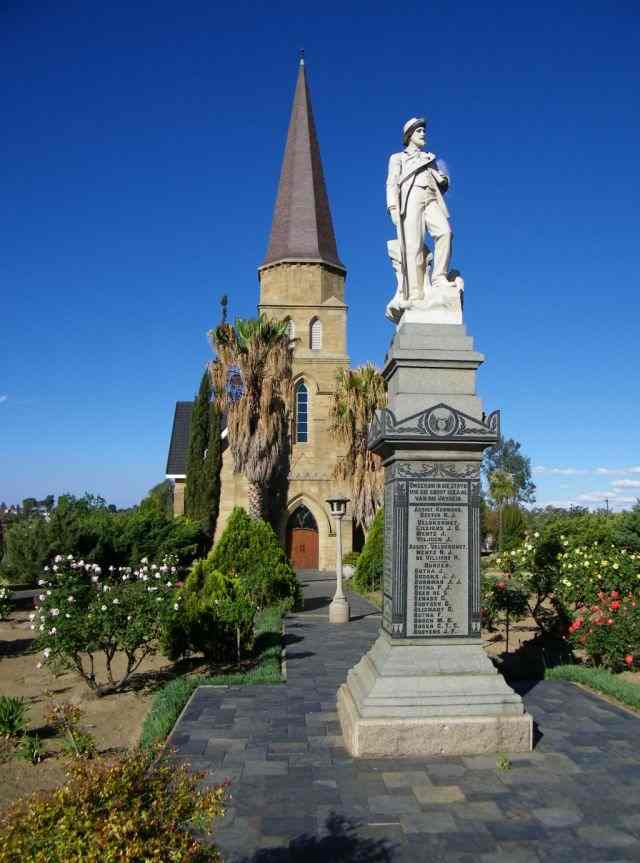
 The congregation of Heilbron was first established in 1874, it was seceded from Kroonstad. A beautiful sandstone building of the Dutch Reformed church was inaugurated in 1885, the cornerstone was laid by President Brand in 1880.
The congregation of Heilbron was first established in 1874, it was seceded from Kroonstad. A beautiful sandstone building of the Dutch Reformed church was inaugurated in 1885, the cornerstone was laid by President Brand in 1880.
A special mention must be made of the pulpit, seen in the middle of the picture on the right. The congregation of the NG church are very proud of their beautiful pulpit (preekstoel). It has a bit of history.
 According to the plaque, it was in this church from 1885 to 1963. In 1963 the church was remodelled and there was no place for the pulpit. It was bought by one of the missionary churches (Sendings kerk), but for some reason could not be installed. It spent a number of years in storage and was 'found' by Ds PJ Pretorius of Kroonstad, he bought it for 51 Rand, restored it and it got installed in the Morewag church in Kroonstad. In 2014 the Morewag church was sold and the pulpit advertised in the local newspaper. The Heilbron church showed interest and after some negotiation, it was given to them as a present with the condition that it must be re-installed into the church. That was done and the pulpit is back in service.
According to the plaque, it was in this church from 1885 to 1963. In 1963 the church was remodelled and there was no place for the pulpit. It was bought by one of the missionary churches (Sendings kerk), but for some reason could not be installed. It spent a number of years in storage and was 'found' by Ds PJ Pretorius of Kroonstad, he bought it for 51 Rand, restored it and it got installed in the Morewag church in Kroonstad. In 2014 the Morewag church was sold and the pulpit advertised in the local newspaper. The Heilbron church showed interest and after some negotiation, it was given to them as a present with the condition that it must be re-installed into the church. That was done and the pulpit is back in service.
In its grounds is a monument to the Heilbron burgers killed in the Anglo-Boer war. Unfortunately access to the grounds is restricted by a big fence around it. Something that has become necessary for most churches due to littering and vandalism.
Methodist Church
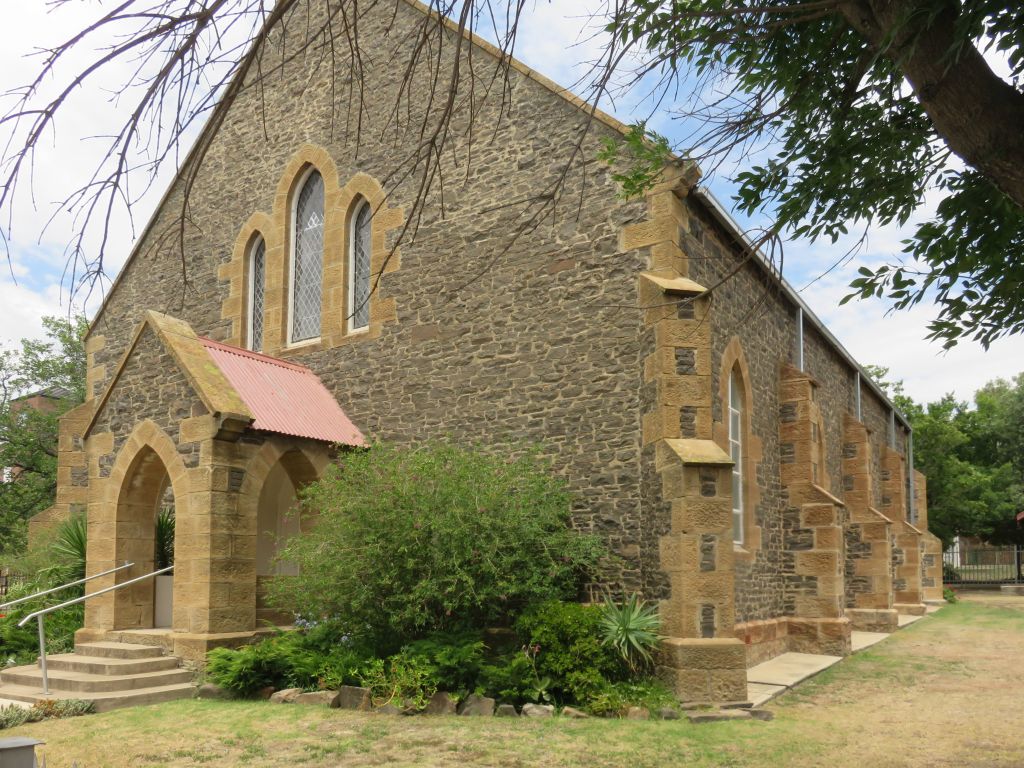
 The Methodist church was erected in the same time period as the NG church, which tells something about the cosmopolitan composition of the population. It becomes noticeable when strolling through the cemetery. There are not only Dutch/Afrikaans names, but also English, Irish, Scottish, German, Hollands and Jewish names.
The Methodist church was erected in the same time period as the NG church, which tells something about the cosmopolitan composition of the population. It becomes noticeable when strolling through the cemetery. There are not only Dutch/Afrikaans names, but also English, Irish, Scottish, German, Hollands and Jewish names.
The foundation stone was laid on 28 August 1882 by the then president of the Free State, John H.Brand, the building cost was £2000.
Something interesting from the history of the church are the wall paintings at the pulpit. This dates back to the 1920th when John Pierce, one of the leading member at the time, helped a beggar by giving him some menial tasks in exchange for food and drink. And then discovered that this guy had a talent for painting. He commissioned him to paint the walls above the pulpit. The picture shows what he came up with. The panel on the left is the basic statement of believes and the center and right are the ten commandments.
Wesleyan church
 That was a surprise find, because it is on the other side of the stream, that would have been the black area. It actually pre-dates the NG church and was, I presume, built by a black congregation at the time.
That was a surprise find, because it is on the other side of the stream, that would have been the black area. It actually pre-dates the NG church and was, I presume, built by a black congregation at the time.
The building is not in use, a new, bigger church was built down the hill. We had a look inside the church which unfortunately is in decay. A pity, with a bit of restoration work this church could be a beautiful building.
Presbyterian Church

 And just across from the Wesleyan church we found this old building of the Native Presbyterian church, put up in 1910. Judging by the rusty look and the weeds growing around it this building is not in use. It is a corrugated iron building typical of the early 20th century and I would think would qualify
And just across from the Wesleyan church we found this old building of the Native Presbyterian church, put up in 1910. Judging by the rusty look and the weeds growing around it this building is not in use. It is a corrugated iron building typical of the early 20th century and I would think would qualify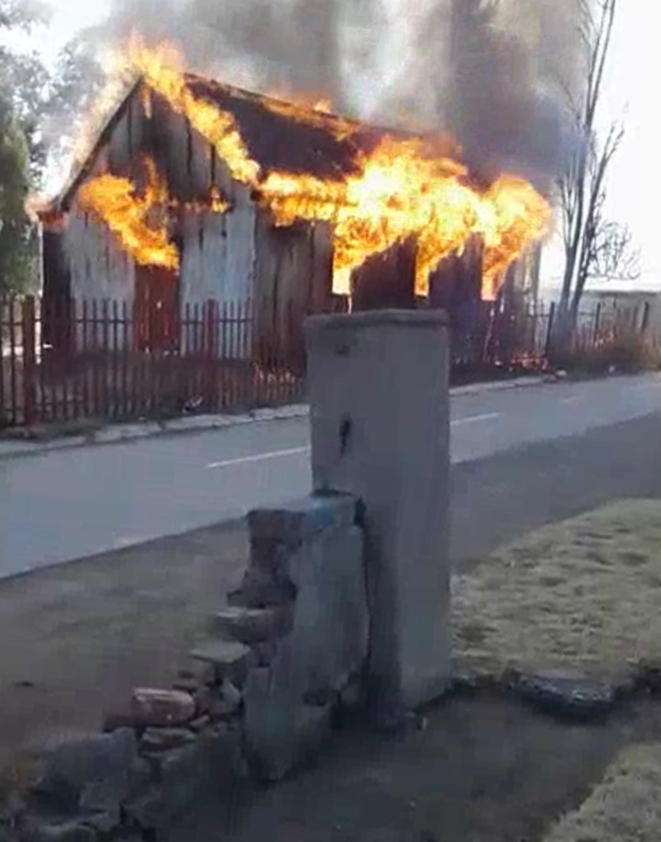 for national monument status. The foudation stone reads: Native; Presbyterian church; Feb.1910; Abraham Poho; Minister.
for national monument status. The foudation stone reads: Native; Presbyterian church; Feb.1910; Abraham Poho; Minister.
PS: it is now July 2018 and the church has burned down, as reported by the Heilbron Herald. Picture by the Heilbron Herald.
Nederduitsch Hervormde Kerk

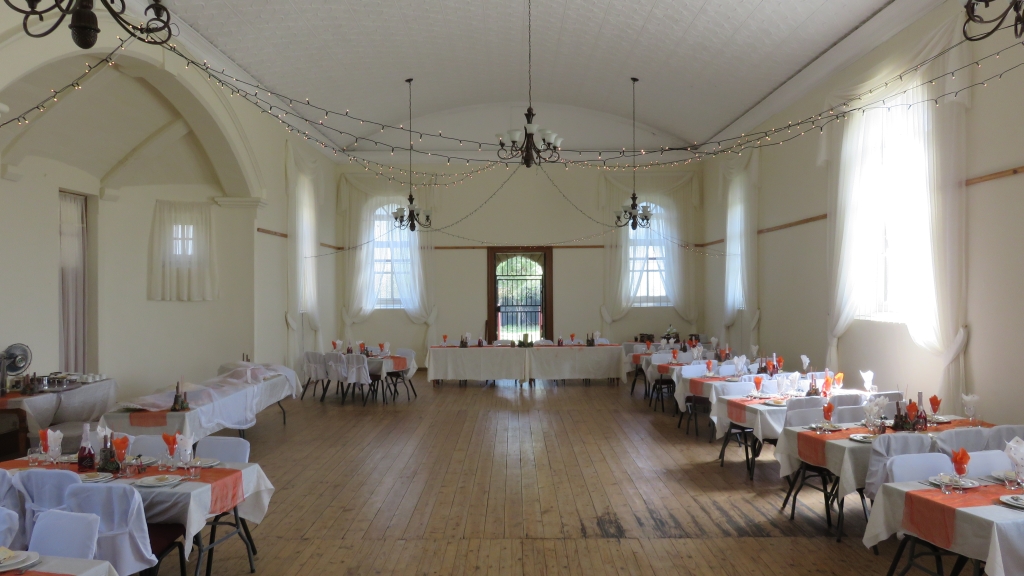 Otherwise known as the Klipkerkie. A congregation of the NH church existed since 1911. The foundation stone to this church was laid in 1913, but the building was only finished in 1916. The delay in completion was caused by the First World War and by the rebellion, which had major support in the area.
Otherwise known as the Klipkerkie. A congregation of the NH church existed since 1911. The foundation stone to this church was laid in 1913, but the building was only finished in 1916. The delay in completion was caused by the First World War and by the rebellion, which had major support in the area.
The building is now only used for functions. A very nice venue for weddings. There is a more modern church building of the NHK at the other end of town.
Railway station

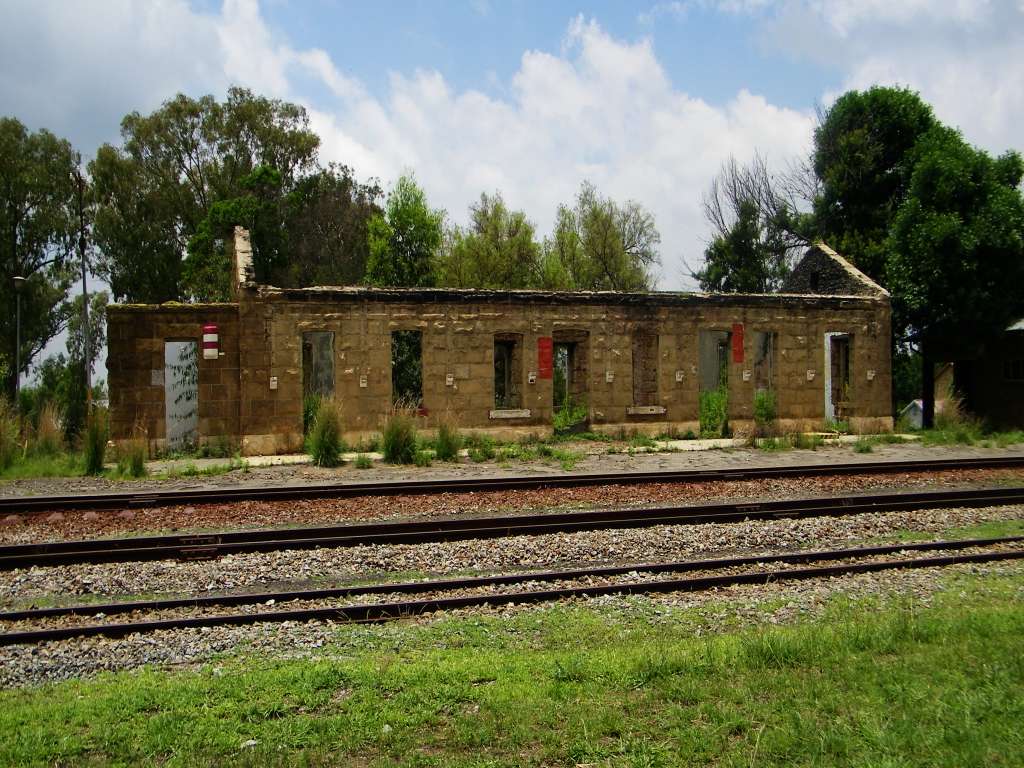 Heilbron was connected by rail to Wolwehoek in 1899. Later the line was extended to Petrus Steyn and Lindley. At the time of writing the rail is not in use and in fact some of the tracks south of Wolwehoek have disappeared (stolen). The Heilbron station building has burned out and is only standing as a shell. The picture on the left shows the station in 1899 and the one on the right is the building as we found it in 2010.
Heilbron was connected by rail to Wolwehoek in 1899. Later the line was extended to Petrus Steyn and Lindley. At the time of writing the rail is not in use and in fact some of the tracks south of Wolwehoek have disappeared (stolen). The Heilbron station building has burned out and is only standing as a shell. The picture on the left shows the station in 1899 and the one on the right is the building as we found it in 2010.
Anglo Boer war
During the Anglo Boer war Heilbron was the capital of the Free State, but only for a few days, after that it was tented accommodation for the Free State government at Presidents Koppie about 18 km out of town on the way to Frankford.
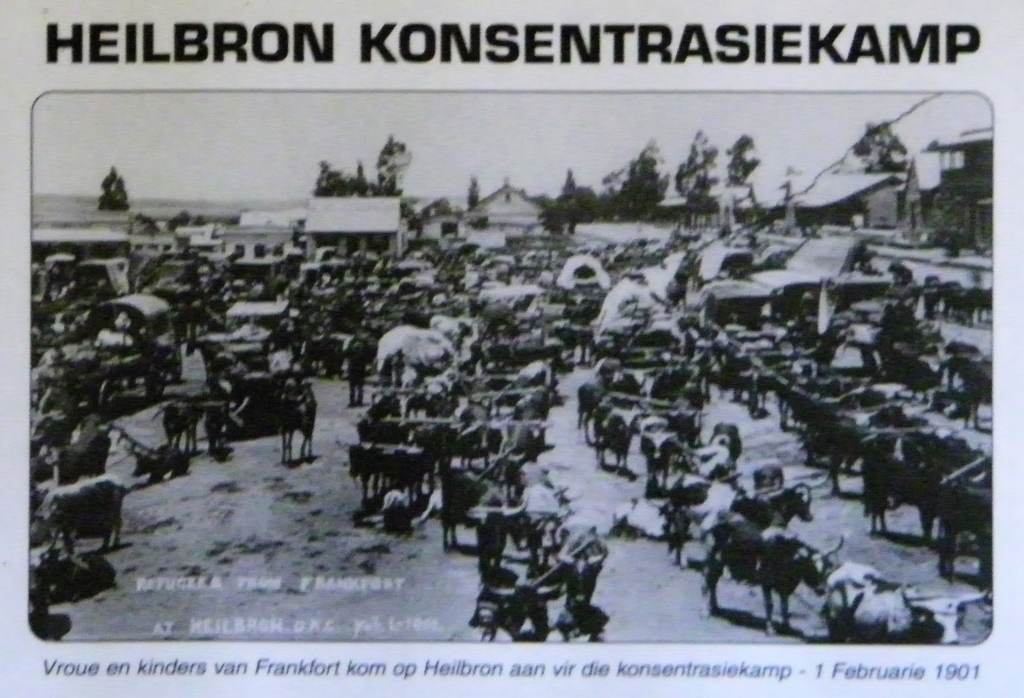 The Anglo-Boer war also touched the town in that it had a concentration camp at a site just across from the Volkschool at the corner Church- and Luyt street.
The camp had a start in December 1900 when the first refugees arrived. They were accommodated in the empty houses of the town. Overcrowding was a problem with up to seven families living in one house. A tented camp was erected at a later stage. A major boost to the numbers was when the town of Frankfort was completely burned down in January 1901.
The Anglo-Boer war also touched the town in that it had a concentration camp at a site just across from the Volkschool at the corner Church- and Luyt street.
The camp had a start in December 1900 when the first refugees arrived. They were accommodated in the empty houses of the town. Overcrowding was a problem with up to seven families living in one house. A tented camp was erected at a later stage. A major boost to the numbers was when the town of Frankfort was completely burned down in January 1901.
Museum
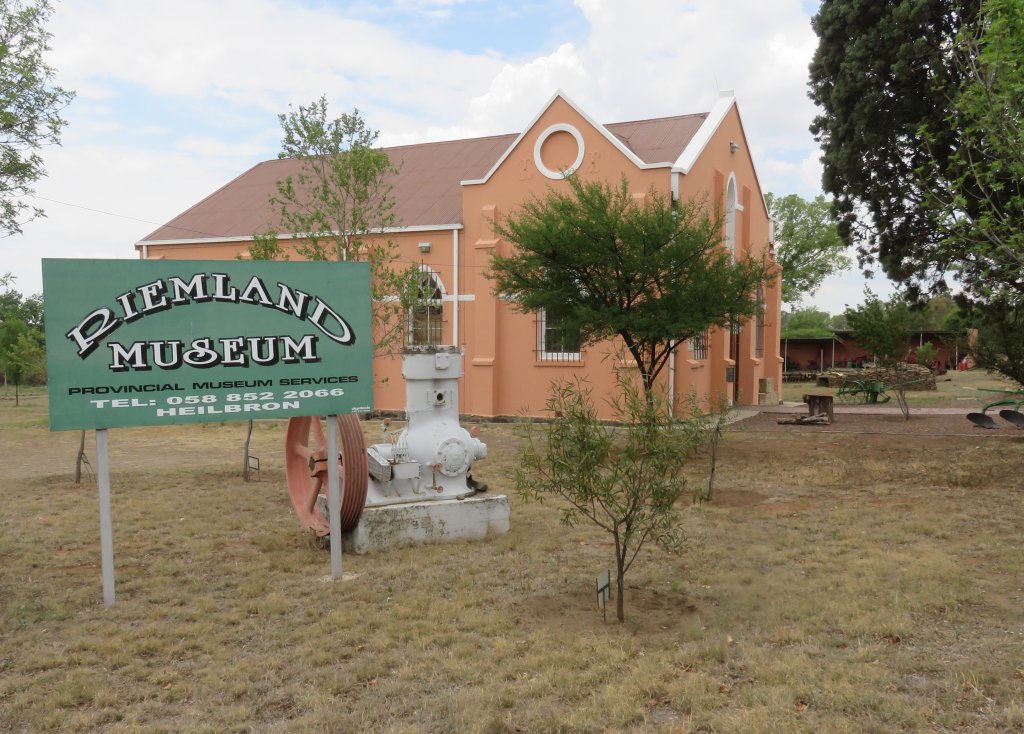 The Riemland museum, is situated in the former synagogue. It goes back to the time when there was a fair number of Jewish people living in and around Heilbron. According to the foundation stone the building was inaugurated in 1912.
The Riemland museum, is situated in the former synagogue. It goes back to the time when there was a fair number of Jewish people living in and around Heilbron. According to the foundation stone the building was inaugurated in 1912.
With time the numbers decreased, mostly through movement to the big cities. The numbers decreased so much that eventually maintaining a synagogue was not sustainable. The building was then donated to the municipality to be used as a museum.
 The curator at the time was Quarta Pretorius, who kept it well stocked and attractive. When she came up for retirement her replacement had to be a person from a different population group. This didn't work out very well and the place went into decline. You can see Pat in a heavy discussion with the rabbi about this.
The curator at the time was Quarta Pretorius, who kept it well stocked and attractive. When she came up for retirement her replacement had to be a person from a different population group. This didn't work out very well and the place went into decline. You can see Pat in a heavy discussion with the rabbi about this.
Museum services eventually offered the museum back to the original team, now Quarta is back, but as an unpaid volunteer. But, at least, the municipality is paying for the water, lights and security. The place has had a complete face lift and all done by volunteers and donations from industry, institutions and individuals. It is a real pleasure to walk through the place to marvel at the exhibits. Well done to Quarta and her team.
Hospital
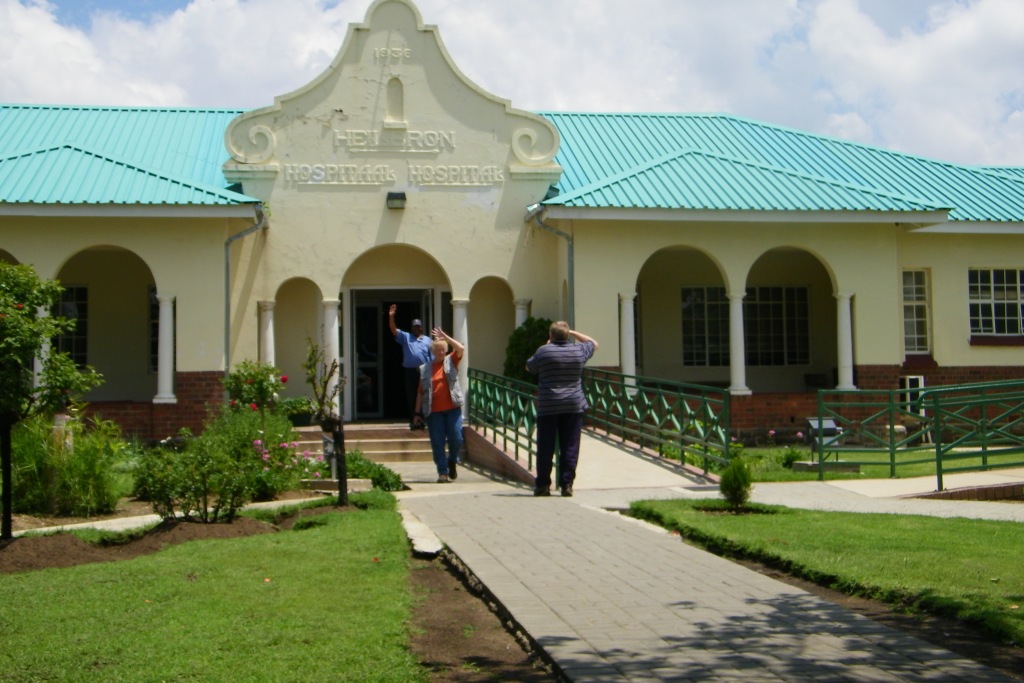
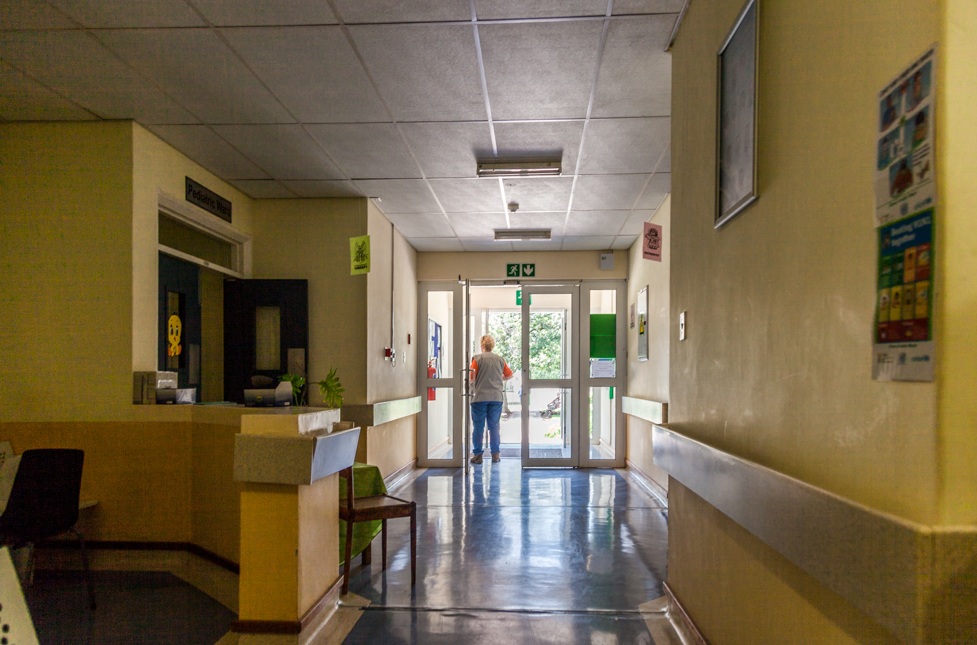 The hospital with its attractive facade was build in 1936, the archidect was Gerard Moerdyk, the designer of the Voortrekker monument. We actually went inside, to me it looked very clean and well maintained, but Pat, as a former matron, had some complaints. We weren't supposed to take pictures, thus eventually the security guard showed us the way out.
The hospital with its attractive facade was build in 1936, the archidect was Gerard Moerdyk, the designer of the Voortrekker monument. We actually went inside, to me it looked very clean and well maintained, but Pat, as a former matron, had some complaints. We weren't supposed to take pictures, thus eventually the security guard showed us the way out.
Cemetery
The cemetery is at the entrance to town coming in from the north. Interesting to wander through, there is the section dedicated to the British soldiers who died in the area during the Anglo Boer war, there are the concentration camp graves with a central monument and a section for the Jewish dead. Of note are a number of old graves over the fence towards the stream. Judging by the names on the head stones these are graves of black people. An indication that black people lived in the vicinity and occupied the area on the northern side of the stream in the early years of the town.
British war graves

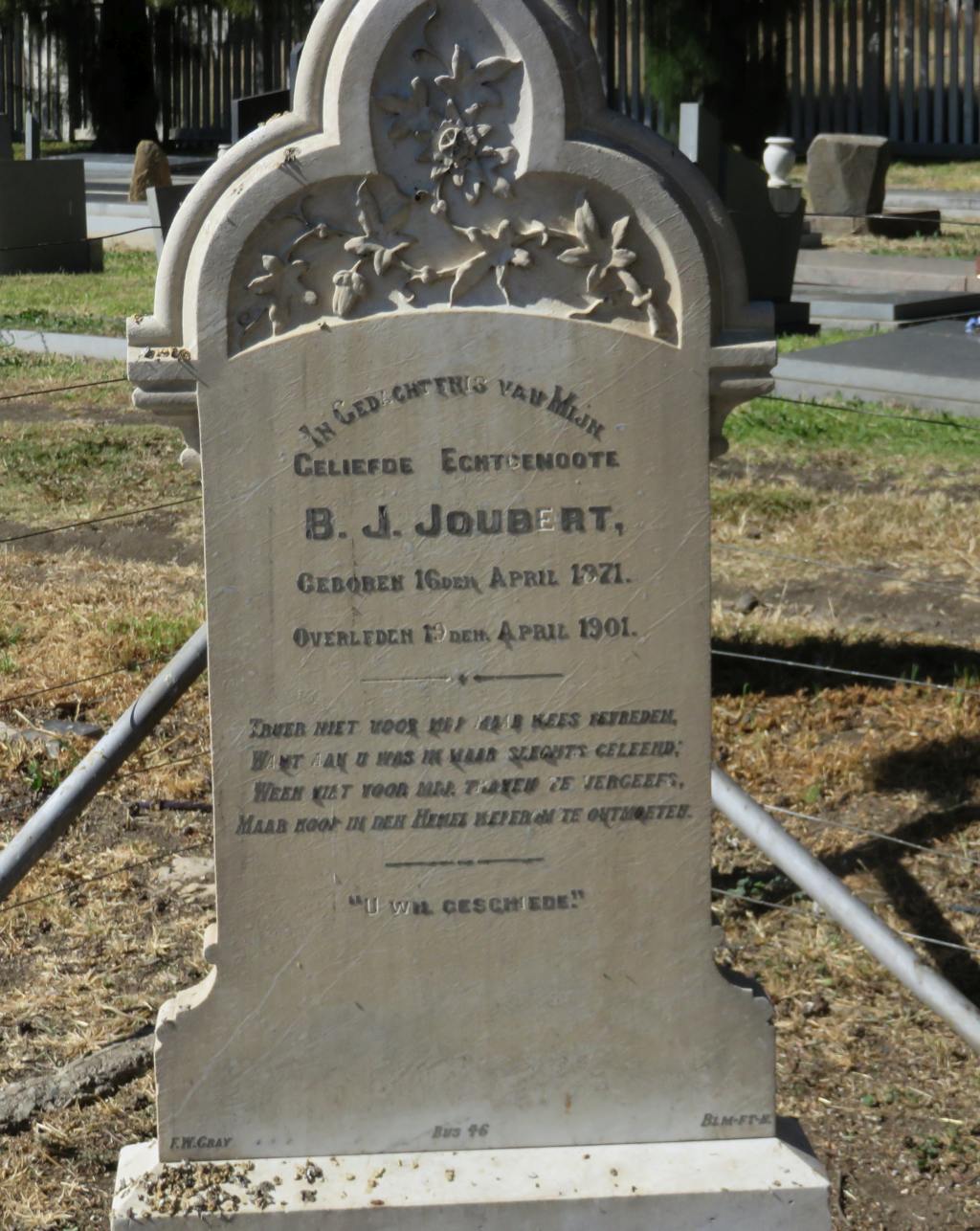 One square in the cemetery is allocated to British war graves of the Anglo Boer war of 1899 to 1902. One grave stone that pricked my interest is that of JB Joubert, the language on the stone is Dutch. He must have been one of Boer fighters who gave up earlier in the war, joining the British to fight in the South African Constabulary. I need to find out more about this, watch this space.
One square in the cemetery is allocated to British war graves of the Anglo Boer war of 1899 to 1902. One grave stone that pricked my interest is that of JB Joubert, the language on the stone is Dutch. He must have been one of Boer fighters who gave up earlier in the war, joining the British to fight in the South African Constabulary. I need to find out more about this, watch this space.
Concentration camp graves
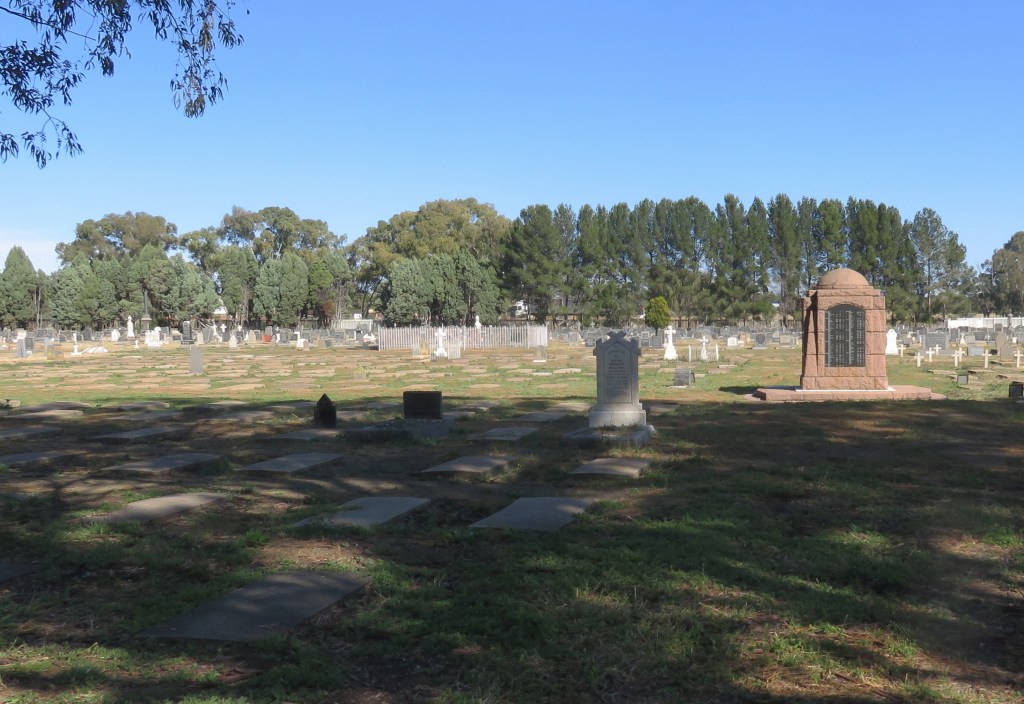 789 mostly woman and children died in the concentration camp as a result of disease that spread through the camp.
789 mostly woman and children died in the concentration camp as a result of disease that spread through the camp.
Burger graves from the Boer War
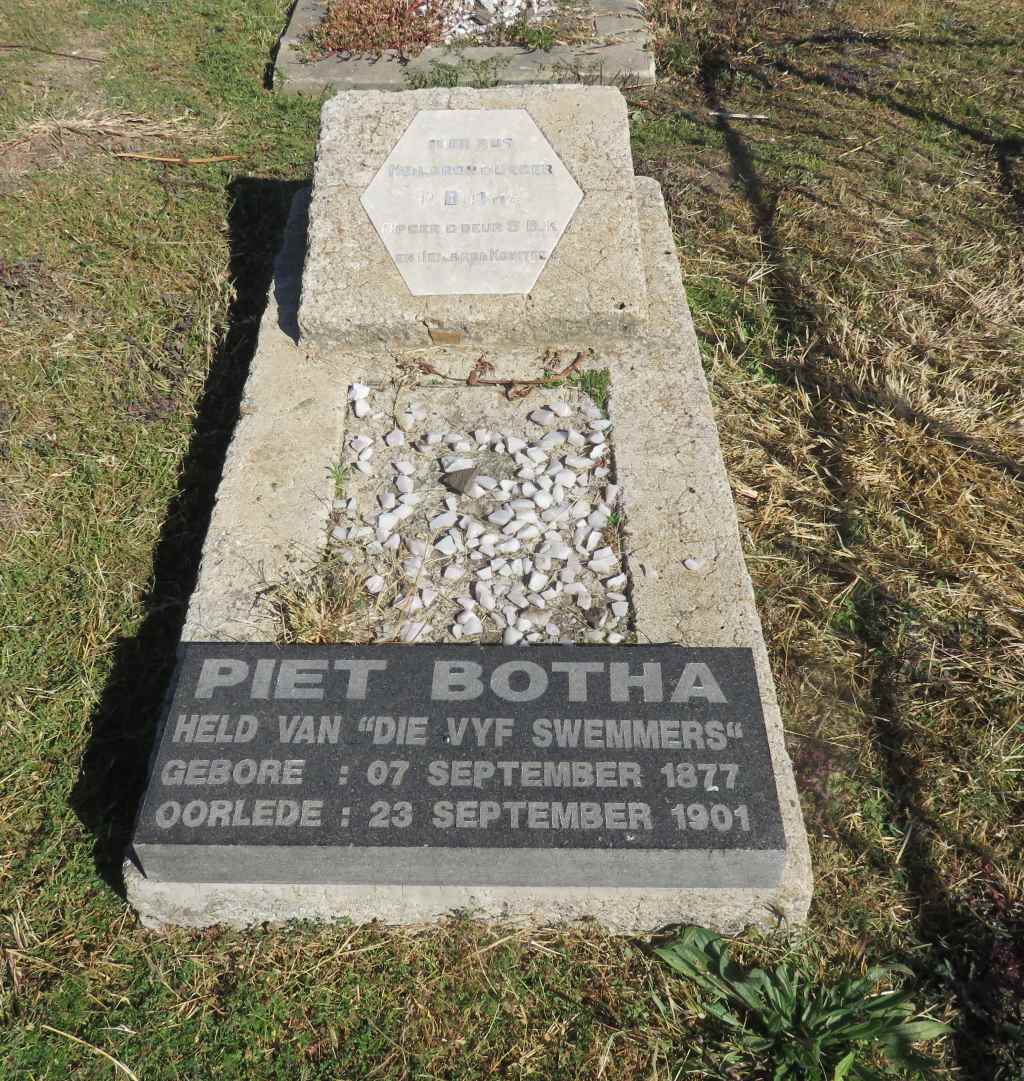 The grave that attracted my attention is that of Piet Botha. He was one of the five swimmers that escaped British captivity when landing at Ceylon. The five swimmers were, Lourens Steytler, George Steytler, Willie Steyn, Piet Botha and a German named Hausner. They had been taken prisoner in the Free State and taken to the Groenpunt POW camp at Cape Town before shipping out to Ceylon (now Sri Lanka) on the troop carrier "Catalonia" on 15 November 1899. The boat arrived on the 9 January 1900 in Colombo. Some of the prisoners were taken off the same day and some were still left on the boat and allowed to sleep on deck, I presume because of the heat. This was an opportunity for the five to make their escape by letting themselves into the water using ropes. They swam to the Russian ship, Tchersson, which was about 2 miles from the troop carrier they had escaped from. Thus they had to swim for about three kilometre. What helped was that they had equipped themselves with cork belts. The Russians took them to the Crimea, from there they made their way to St Petersburg and on to Holland, visiting Paul Kruger, who was in exile there. In Germany they could board a steamer that took them to German South West Africa (Namibia). This gave them the opportunity to rejoin the war.
The grave that attracted my attention is that of Piet Botha. He was one of the five swimmers that escaped British captivity when landing at Ceylon. The five swimmers were, Lourens Steytler, George Steytler, Willie Steyn, Piet Botha and a German named Hausner. They had been taken prisoner in the Free State and taken to the Groenpunt POW camp at Cape Town before shipping out to Ceylon (now Sri Lanka) on the troop carrier "Catalonia" on 15 November 1899. The boat arrived on the 9 January 1900 in Colombo. Some of the prisoners were taken off the same day and some were still left on the boat and allowed to sleep on deck, I presume because of the heat. This was an opportunity for the five to make their escape by letting themselves into the water using ropes. They swam to the Russian ship, Tchersson, which was about 2 miles from the troop carrier they had escaped from. Thus they had to swim for about three kilometre. What helped was that they had equipped themselves with cork belts. The Russians took them to the Crimea, from there they made their way to St Petersburg and on to Holland, visiting Paul Kruger, who was in exile there. In Germany they could board a steamer that took them to German South West Africa (Namibia). This gave them the opportunity to rejoin the war.
The story has been researched by Prof.C.J Barnard culminating in a book "Die vyf swemmers" and is also told in Ref 9.
Jewish section
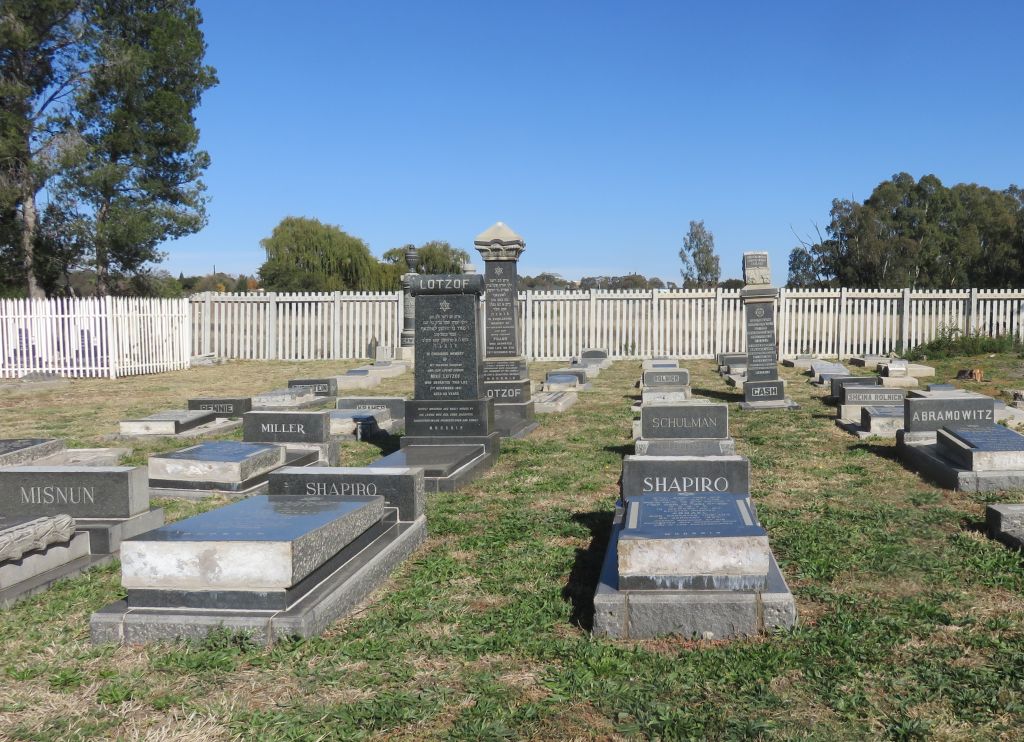 Heilbron, like most Free State towns, had a substantial Jewish community. So substantial that they could built a synagogue in 1912. With shrinking numbers the synagogue became unsustainable and was donated to the municipality. It is now used as a museum, see above under heading 'museum'.
Heilbron, like most Free State towns, had a substantial Jewish community. So substantial that they could built a synagogue in 1912. With shrinking numbers the synagogue became unsustainable and was donated to the municipality. It is now used as a museum, see above under heading 'museum'.
Vegkop
Vegkop is the site of a battle between the Voortrekkers and the Matabele which took place in 1836. There is a lot to be written about that I decided to give it its own page, here is the hyperlink to Vegkop.
Weilbach farm
A historical farm, its official name: 'Leeupoort', not far out of town.I was going to include it in this page, but there is to much to write about, thus a separate web page has been called for.
Personalities of Heilbron
Not arranged in any order of importance or significance, just a collection of names I have come across in my research.
John Pierce
 John Pierce was one of the early and successful businessmen of Heilbron. During the auction in September 1872 he bought a business stand for £100 in President Street, that is just behind the church looking from church street.
Who was John Pierce?
John Pierce was one of the early and successful businessmen of Heilbron. During the auction in September 1872 he bought a business stand for £100 in President Street, that is just behind the church looking from church street.
Who was John Pierce?
His early history is a bit unclear. What I found on the Internet was that he was born in London in 1850 and came to Natal with his mother, Elizabeth, as a young child. Her husband, and father of the child, was David Towers Pierce, a blacksmith working in Natal. The father died in 1859. John's mother bound him in 1862 by contract to a Pietermaritzburg businessman, Joseph de Kock, for 5 years to be an errand boy and to be useful in the household and business. The term 'bound' I presume means some sort of apprenticeship. It is stated that he was well liked by everyone he came in contact with.
That is one version, another version in Ref.8 states that he was taken in by the family when he arrived at their wagons on the way to Kroonstad as a 9 year old orphan. The de Kock family moved to Kroonstad in 1865. That version doesn't make much sense, I'll opt for the first story.
 As stated above under 'history', he bought one of the first stands becoming available in the auction of 1872. At that time he had already set himself up in the business of selling and buying. He worked the area as a 'smouse', a very fitting Afrikaans word describing someone who travels from farm to farm selling commodities and buying or bartering farm produce. But it is still interesting to consider where he would have managed to obtain the stately sum of £100 to pay for the stand. A pointer is possibly at the bottom of the advertisement, which says 'a liberal credit will be given'.
As stated above under 'history', he bought one of the first stands becoming available in the auction of 1872. At that time he had already set himself up in the business of selling and buying. He worked the area as a 'smouse', a very fitting Afrikaans word describing someone who travels from farm to farm selling commodities and buying or bartering farm produce. But it is still interesting to consider where he would have managed to obtain the stately sum of £100 to pay for the stand. A pointer is possibly at the bottom of the advertisement, which says 'a liberal credit will be given'.
Immediately he set up his first shop in President street. Joseph de Kock, also opened a shop in Church street, but soon after the two combined into one company, it became John Pierce & Co.
He later opened a second shop, this one in Wolwehoek. The receipt displayed shows that a Mr.van Heerden bought 2 bags of meal (I presume that was maizemeal) and a bag of salt on Tuesday, 29-7-1910. He paid £3 10 schilling for the two bags, that would be £1 and 15 shilling for one bag. I did this calculation just to illustrate how difficult currency calculations were in those days, £1 had 20 shilling and one shilling had 12 pence. Things are much easier nowadays with decimal currencies.
He was not only a merchant, but also a banker lending money. Check Deneysville for the story of the Engelbrecht pont. He lent £300 for that project in 1888.
Being one of the important business people he was also on the town council. In the Vegkop museum I saw the minutes of one of the meetings, the first sentence reads: 'first meeting of the Heilbron municipality was held at Mr.J.Pierce's home on Tuesday, , 3rd April 1888'. And yes, the minutes were written in English, which illustrates the English influence in the Free State even before the Boer War.
1876 he married Phillipina Johanna de Kock, a younger sister of Joseph de Kock.
 At the beginning of the Boer war he would have been required to report for duty in the commandos. But the law also provided that he could send a substitute, which he did. That was J.J.Lombard who received £5 every month, even when he was sent to prison in Ceylon. Whilst away JP also accumulated animal stock for his substitute which he cared for on his farm. On the return from Ceylon he was able to collect about 200 animals which he took to his farm in the Cape.
At the beginning of the Boer war he would have been required to report for duty in the commandos. But the law also provided that he could send a substitute, which he did. That was J.J.Lombard who received £5 every month, even when he was sent to prison in Ceylon. Whilst away JP also accumulated animal stock for his substitute which he cared for on his farm. On the return from Ceylon he was able to collect about 200 animals which he took to his farm in the Cape.
He died in 1919 and his wife 1920, the grave stones read: In Memoriam; John Pierce; 1850-1919; "who lived for others"' That last sentence sums up his life, he was known to be very charitable and helped many of the people in Heilbron and surround. And on his wife's grave: In Memoriam; Philippina; Johanna Pierce; 1852-1920.
Heilbron water supply
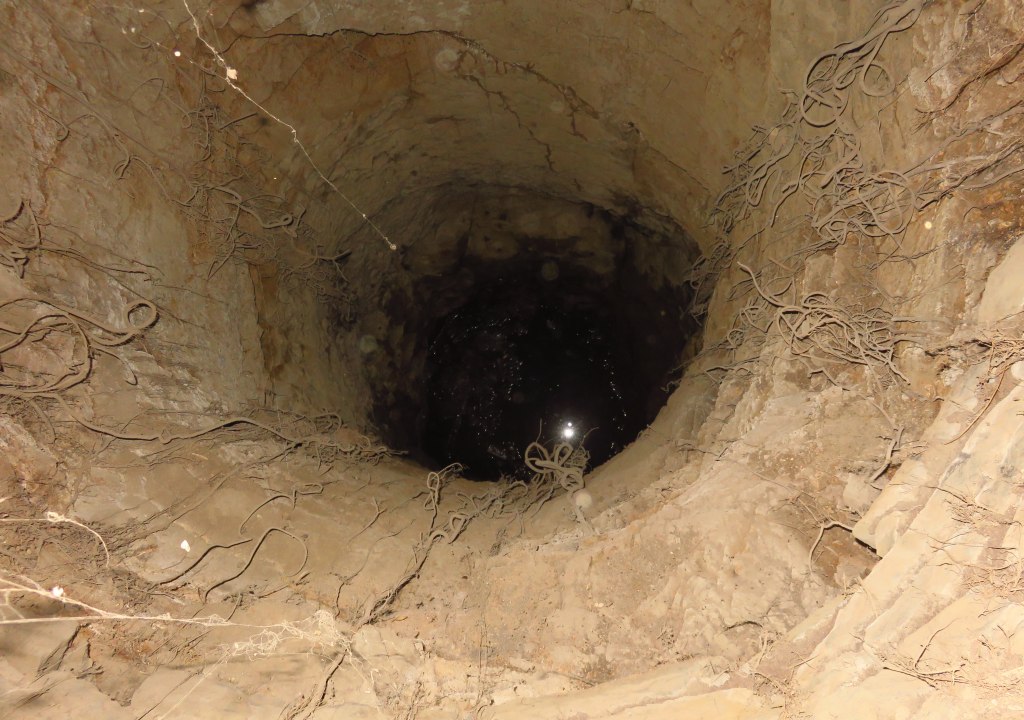 We found this well in one of the backyards in Tanner street. It is very unusual to have a well, boreholes are more common for water supply. A thought is that this could have been part of the water supply for the village in the early days. The well is 12 meter deep and we were told has about 2m water depth. It is not being used and is kept well covered to prevent accidents. I have to do a bit of research about he towns water supply, watch this space.
We found this well in one of the backyards in Tanner street. It is very unusual to have a well, boreholes are more common for water supply. A thought is that this could have been part of the water supply for the village in the early days. The well is 12 meter deep and we were told has about 2m water depth. It is not being used and is kept well covered to prevent accidents. I have to do a bit of research about he towns water supply, watch this space.
the Rebellion
The rebellion was a rebellion of many Boers against the South African government at the beginning of World War 1. South Africa had joined Britain in the war against Germany and was given the task of occupying German South West Africa. The rebells were against this since they considered Germany to be a friend of the Boers and secondly they saw this as an opportunity to regain the independence of the republics. The movement was very strong in the Heilbron area, one of their leaders was Christian de Wet. It has been reported that 15 of the teachers in the Heilbron district had joined the rebellion and were suspended from the school. Other teachers had joined the "Union Forces". It badly affected school activities with a few of the smaller schools in the district closing for some time. 

One of the first casualties was HA Roets, he lost his life in an engagement on the farm Welverdien. There is a verbal account of what happened, it was told to us by Benny Roets. I cannot confirm the accuracy of the story, but here it is. Roets and some others were on their way to or from a meeting of the rebels and were met by a group of armed blacks on the farm Welverdien. A fight ensued during which Roets was shot and killed. The wall of the kraal where this happened was removed some time ago.
Roets was buried on his farm Geelwal next to Welverdien. The inscription reads, translated: Here rests my husband and father; Hendrik Adriaan Roets; born 19 Sept 1883; killed in action 13 Nov 1914; for folk and fatherland; in remembrance of the late husband; MMM Roets and children.
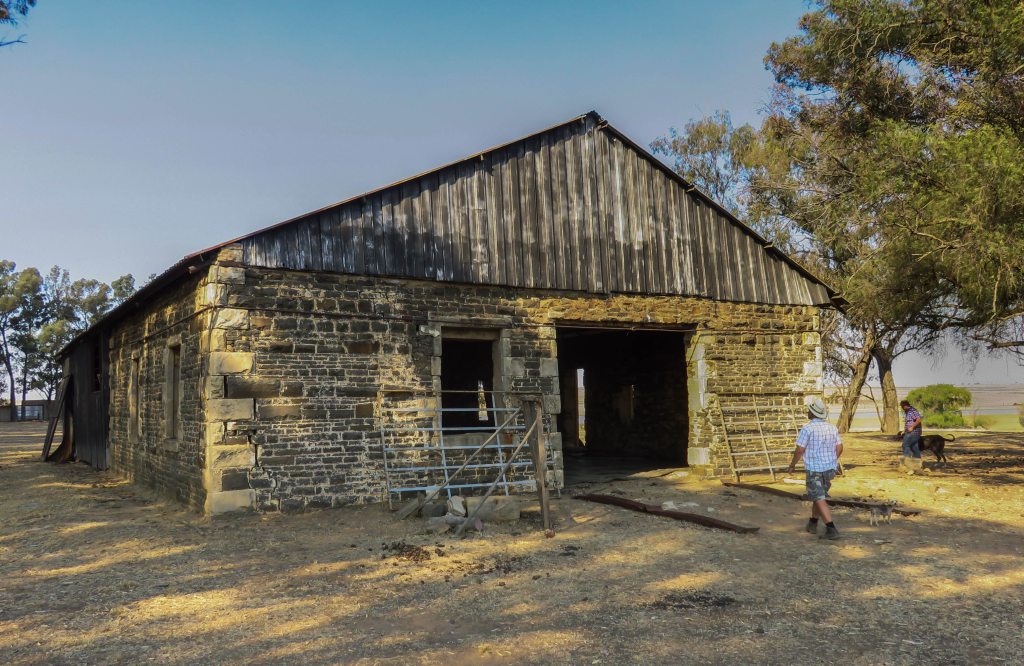 And whilst on the farm Geelwal there is something else to be see. The picture shows the walls of a house, the farmer has preserved the walls by building a big shed over it. It did serve as a wedding venue once. Well, the story of the house is that it was one of the very few houses in the district that was not burned down during the Boer War. We think it was possibly used as a base by the British, some British ammunition found nearby seem to prove this point. It
And whilst on the farm Geelwal there is something else to be see. The picture shows the walls of a house, the farmer has preserved the walls by building a big shed over it. It did serve as a wedding venue once. Well, the story of the house is that it was one of the very few houses in the district that was not burned down during the Boer War. We think it was possibly used as a base by the British, some British ammunition found nearby seem to prove this point. It 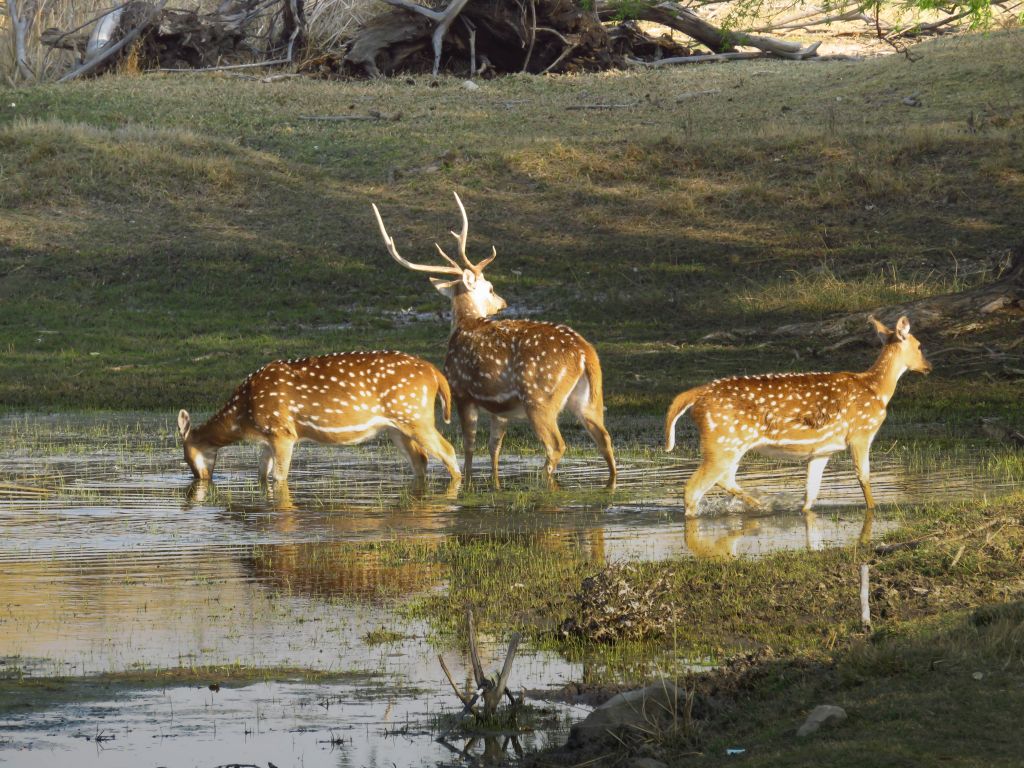 would also have been the house where HA Roets grew up.
would also have been the house where HA Roets grew up.
And look at this picture of some deer, it has nothing to do with the story. But I love these gracious animal, they are so beautifull. We found them grazing at Geelwal, they are not endemic to South Africa, their origins is Europe and Asia. I have noticed a couple of places in the Free State where these animals are kept.
Progress
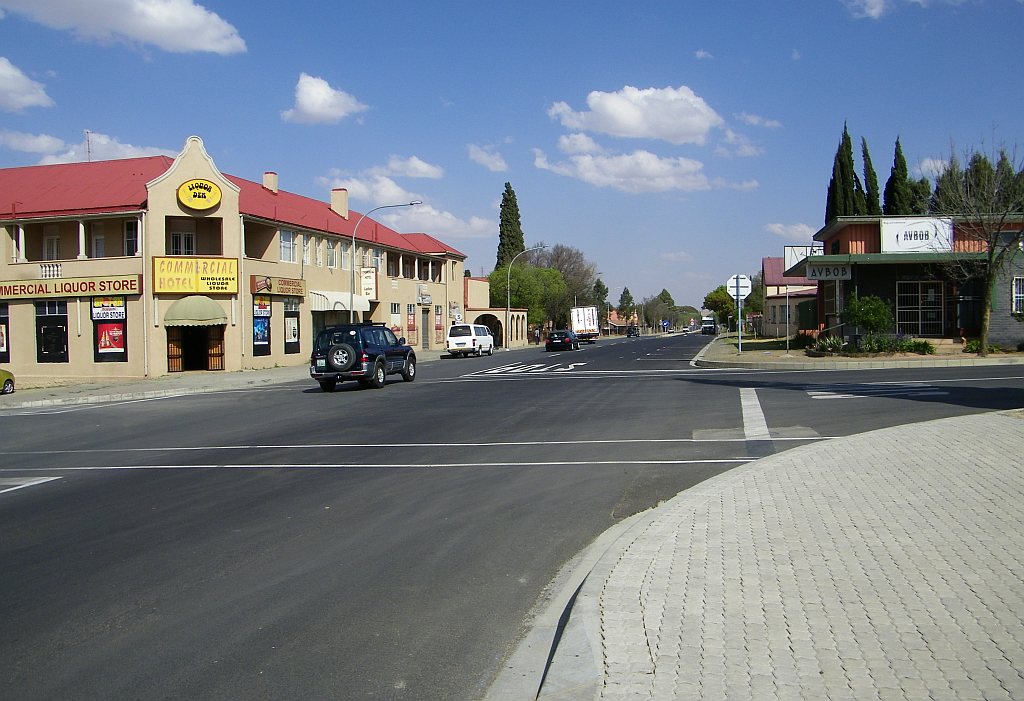 Yes, there has been progress, the main road through town which has been in a pot holy state for at least 20 years has finally been refurbished. That is what it looks like now, September 2013.
Yes, there has been progress, the main road through town which has been in a pot holy state for at least 20 years has finally been refurbished. That is what it looks like now, September 2013.
References
Ref 1.: Standard Encyclopedia of Southern Africa, Nasou Limited, 1974
Ref 2.: Brochure 'Break away to the Riemland', issued by the Heilbron Tourism Forum
Rev 3.: 'The Orange Free State - its pastoral, agricultural and industrial resources', compiled by Somerset Playne, printed by the foreign and colonial, compiling and publishing company, 1912
Ref 4.: GBA Gerdener, Sarel Cilliers - die Vader van Dingaansdag, 1919
Ref 5.: Prof.MCE van Schoor, Vegkop, a brochure issued by the the National Monuments Counci, 1984
Ref 6.: Daniel F.Erasmus, 'Heilbron 1873-1973 Feesalbum'
Ref 7.: J.C.Steenkamp, 'Die Geskiedenis van Heilbron en Distrik tot 1952'
Ref 8.: 'Die de Kocks van Heilbron', saamgestel deur Sita de Kock (Bosman), 1972
Ref 9.: J.Scheibert, Der Freiheitskampf der Buren, Verlag A.Schröder, 1902
I also have to thank Piet Lombard for numerous pictures and documents made available to me.